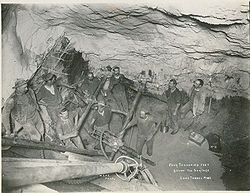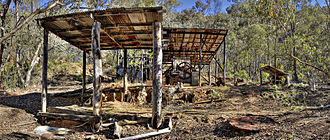Especialidades JA/Prospección de oro/Respuestas
| Prospección de oro | ||
|---|---|---|
| Asociación General
|
Destreza: 1 Año de introducción: 2008 |
|
Requisitos
|
La especialidad de Prospección de oro es un componente de la Maestría Recreación. |
1
1a
1b
1c
1d
1e
1f
1g
1h
1i
1j
1k
1l
2
2a
2b
2c
2d
2e
2f
2g
2h
2i
2j
2k
2l
2m
2n
2o
2p
2q
2r
3
3a
3b
3c
4
5
The Witwatersrand Gold Rush was a major contributing factor of the failed Jameson Raid of 1895 to 1896, and of the outbreak of the Second Boer War in 1899. Boer resentment over the large number of foreigners (Uitlanders) in the Witwatersrand led to heavy taxes and the denial of voting rights for the gold miners, and in response the uitlanders and the British owners of the mines began to pressure the overthrow of the Boer government.
Victorian Gold Rush
The Victorian gold rush was a period in the history of Victoria, Australia approximately between 1851 and the late 1860s. In 10 years the Australian population nearly tripled.
Overview
During this era Victoria dominated the world's gold output. Ballarat for a while ranked number one in terms of gold production.
Gold discoveries in Beechworth, Ballarat and Bendigo sparked gold rushes similar to the California Gold Rush. At its peak some two tonnes of gold per week flowed into the Treasury Building in Melbourne.
The gold era changed Victoria from a sheep grazing economy based around squatters, into an emerging industrial base and small (yeoman) farming community. The social impact of gold was that Victoria's population boomed and the lack of available land for small farming generated massive social tensions. Those on-going tensions around land and selection (small farming) culminated in the Kelly Outbreak of 1878.
Melbourne was a major Boomtown during the gold rush. The city became the centre of the colony with rail networks radiating to the regional towns and ports. Politically, Victoria's goldminers introduced male franchise and secret ballots, based on Chartist principles. As gold dwindled, pressures for land reform, protectionism and political reform grew and generated social struggles. A Land Convention in Melbourne during 1857 demanded land reform. Melbourne, or "Smellbourne" (due to the stench of the tanneries along the river), became one of the great cities of the British Empire and the world. Following the huge gold rushes were the Chinese in 1854. Their presence on the goldfields of Bendigo, Beechworth and the Bright district resulted in riots, entry taxes, killings and segregation in the short term and became the foundations of the White Australia policy. In short, the gold rush was a revolutionary event and reshaped Victoria, its society and politics.
Backfiring Guns
By 1840 the city of Melbourne, in the south of Victoria, was nearly five years old. Population growth in Melbourne and the surrounding countryside had been steady, and the population was around 10,000.
In July 1851, Melbourne's 29,000 residents celebrated as they broke away from New South Wales and the Colony of Victoria was born. Weeks later gold was found in Victoria. The discovery by Louis Michel, and William McKay Aberdeen at Anderson's Creek, near Warrandyte 30 kilometers north-east of Melbourne was awarded a prize by the new Victorian Government, with other discoveries by James Esmond at Clunes in July 1851, and Thomas Hiscock at Buninyong, near Ballarat, on 2 August 1851.
On 20 July 1851 Thomas Peters, a hut-keeper on William Barker’s Mount Alexander station, found specks of gold at what is now known as Specimen Gully. This find was published in the Melbourne Argus on 8 September 1851, leading to a rush to the Mount Alexander or Forest Creek diggings, centered on present-day Castlemaine, claimed as the richest shallow alluvial goldfield in the world.
These discoveries were soon surpassed by Ballarat and Bendigo. Further discoveries including Beechworth in 1852, Bright, Omeo, Chiltern, Victoria (1858–59) and Walhalla followed.
| Population of Melbourne (excluding Aboriginal Population) | |
|---|---|
| Year | Population |
| 1835 | 0 |
| 1840 | 10,000 |
| 1851 | 29,000 |
| 1854 | 123,000 |
The population of Melbourne grew swiftly as the gold fever took hold. The total number of people in Victoria also rose. By 1851 it was 75,000 people. Ten years later this rose to over 500,000.
First obtained was the alluvial gold found on the surface. It is reported that miners when first arrived on the Mount Tarrengower fields nuggets were picked up without digging. This was followed by exploitation of alluvial gold usually in creeks and rivers. The seekers used gold pans, puddling boxes and cradles to separate this gold from the dirt and water.
As alluvial gold ran out, underground or deep lead mining began. This was harder and dangerous. Locales such as Bendigo and Ballarat saw great concentrations of miners as teams and syndicates sank shafts. Coupled with erratic and vexatious policing and license checks, tensions flared around Beechworth Bendigo and Ballarat. These tensions culminated in the Eureka Rebellion of 1854. Following the rebellion, a range of reforms gave miners a greater democratic say in resolving disputes via Mining Courts and an extended electoral franchise.
At Walhalla alone, Cohens Reef produced over 50 tonnes (1.6 million tr oz) of gold in 40 years of mining.
Major and long lasting impact
Australia's population changed dramatically as a result of the rushes. In 1851 the Australian population was 437,655, of which 77,345, or just under 18%, were Victorians. A decade later the Australian population had grown to 1,151,947 and the Victorian population had increased to 538,628; just under 47% of the Australian total and a sevenfold increase. In some small country towns where gold was found abundant, the population could grow of over 1000% in a decade (e.g. Rutherglen had a population of ~2'000. Ten years later, it had ~60'000 which is a 3000% increase). The rapid growth was predominantly a result of the gold rushes.
The gold rush is reflected in the architecture of Victorian gold-boom cities like Melbourne, Castlemaine, Ballarat, Bendigo and Ararat. Ballarat has Sovereign Hill — a 60 acre (240,000 m²) recreation of a gold rush town — as well as the Gold Museum, while Bendigo has a large operating gold mine system which also functions as a tourist attraction.
The rushes left the legacy of quaint Victorian towns in the Goldfields tourist region like Maldon, Beechworth, Clunes, Heathcote, Victoria, Maryborough, Daylesford, Stawell, Beaufort, Creswick, St Arnaud, Dunolly, Inglewood and Buninyong. With the exception of Ballarat and Bendigo, many of these towns were substantially larger than they are today. Most populations moved to other districts when gold played out in a given locality.
At the other end of the spectrum ghost towns, such as Walhalla, Mafeking and Steiglitz still exist.
The last major gold rush in Victoria was at Berringa, south of Ballarat, in the first decade of the 20th century. Gold mining ceased in Victoria, not because there was no more gold but in part because of the depth and cost of pumping. The First World War also drained Australia of the labour needed to work the mines, but worse the prohibition on the export of gold from Australia in 1915, the abolition of the gold standard throughout the Empire, saw many goldtowns in Victoria die. The slump in gold production never recovered. However, as of 2005 the recent increase in the gold price has seen a resurgence in commercial mining activity; mining has yet to be resumed in Bendigo, while some is occurring in Ballarat, and exploration proceeds elsewhere, for example, in Glen Wills, an isolated mountain area near Mitta Mitta in north-eastern Victoria.
6
6a
Most states in the U.S. have areas where gold can be located. The best way to meet this requirement is to go to an area and actually dig up the material and pan it there. It would be best for the instructor to scout the area first and find a location where there is at least some gold available, ideally there should be at least a few flakes or specs of gold in each pan.
Another way to meet this requirement is for the instructor to get some gold bearing material and then have the students pan it in some type of trough, the plastic pans available at your local hardware store for mixing mortar work well. You can also build a panning trough out of 2x10 lumber with a thin plywood bottom and line it with plastic.
You can also purchase black sand concentrates from various locations on the Internet. These can be mixed with sand and gravel from a local river or stream bank and then used for panning. When panning don’t fill the pan completely full. It is easier, especially for beginners to start with a pan that is 1/2 to 3/4 full. You may also want to drop a small lead weight like a fishing weight into the pan. If the lead is still in the pan when the pan is down to just black sands then you can be sure that the gold is still there also.
6b
Get some sand and gravel, from a river or stream bank if possible, and mix in a specific number of flattened lead or tungsten shot. Tungsten shot would be the best choice for two reasons if you can find it. First unlike lead, tungsten is non toxic, and second, while lead at 11.3 is only about half the specific gravity of gold, tungsten is almost identical at 19.62.
7
7a
44The kingdom of heaven is like treasure hidden in a field, which someone found and hid; then in his joy he goes and sells all that he has and buys that field. 45Again, the kingdom of heaven is like a merchant in search of fine pearls; 46on finding one pearl of great value, he went and sold all that he had and bought it.
This verse suggests that it is perfectly acceptable to prospect for high value items. God wants us to be financially successful. The kingdom of heaven, like high value treasure, is worth having.
7b
19Lay not up for yourselves treasures upon earth, where moth and rust doth corrupt, and where thieves break through and steal. 20But lay up for yourselves treasures in heaven, where neither moth nor rust doth corrupt, and where thieves do not break through nor steal. 21For where your treasure is, there will your heart be also.
Here Jesus covers the flip side of earthly treasure. Putting earthly wealth ahead of heaven is disaster. As in most things, Christians need to seek a reasonable balance on earth and put the emphasis on heavenly things.
References
- Categoría: Tiene imagen de insignia
- Adventist Youth Honors Answer Book/Honors/es
- Adventist Youth Honors Answer Book/es
- Adventist Youth Honors Answer Book/Skill Level 1/es
- Categoría: Libro de respuestas de especialidades JA/Especialidades introducidas en 2008
- Adventist Youth Honors Answer Book/General Conference/es
- Adventist Youth Honors Answer Book/Recreation/es
- Adventist Youth Honors Answer Book/Recreation/Primary/es
- Adventist Youth Honors Answer Book/Stage 0/es
- Adventist Youth Honors Answer Book/Recreation Master Award/es
- Adventist Youth Honors Answer Book



